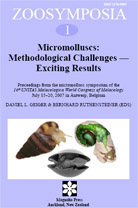Type: Article
Published: 2008-07-25
Page range: 15–38
Abstract views: 1243
PDF downloaded: 2
Niku-nuki: a useful method for anatomical and DNA studies on shell-bearing
Mollusca
Gastropoda
Bivalvia
Scaphopoda
anatomy
DNA analysis
soft parts
specimen preparation

